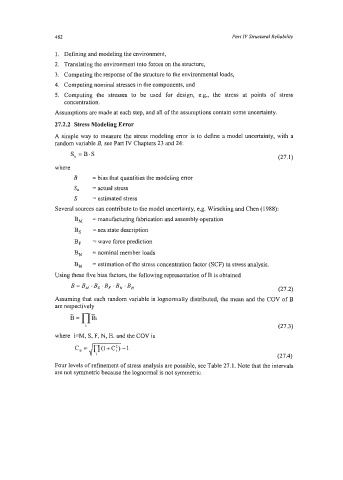Page 506 - Marine Structural Design
P. 506
482 Part IV Structural Reliability
1. Defining and modeling the environment,
2. Translating the environment into forces on the structure,
3. Computing the response of the structure to the environmental loads,
4. Computing nominal stresses in the components, and
5. Computing the stresses to be used for design, e.g., the stress at points of stress
concentration.
Assumptions are made at each step, and all of the assumptions contain some uncertainty.
27.2.2 Stress Modeling Error
A simple way to measure the stress modeling error is to define a model uncertainty, with a
random variable B, see Part IV Chapters 23 and 24:
S, =B-S (27.1)
where
B =bias that quantities the modeling error
Sa = actual stress
S = estimated stress
Several sources can contribute to the model uncertainty, e.g. Wirsching and Chen (1988):
B, = manufacturing fabrication and assembly operation
B, = sea state description
B, = wave force prediction
B, = nominal member loads
BH = estimation of the stress concentration factor (SCF) in stress analysis.
Using these five bias factors, the following representation of B is obtained
B = B, . B, . B, B, . B, (27.2)
Assuming that each random variable is lognormally distributed, the mean and the COV of B
are respectively
(27.3)
where i=M, S, F, N, H. and the COV is
c, =JV-l
(27.4)
Four levels of refinement of stress analysis are possible, see Table 27.1. Note that the intervals
are not symmetric because the lognormal is not symmetric.

